#吹抜けリビング
Photo
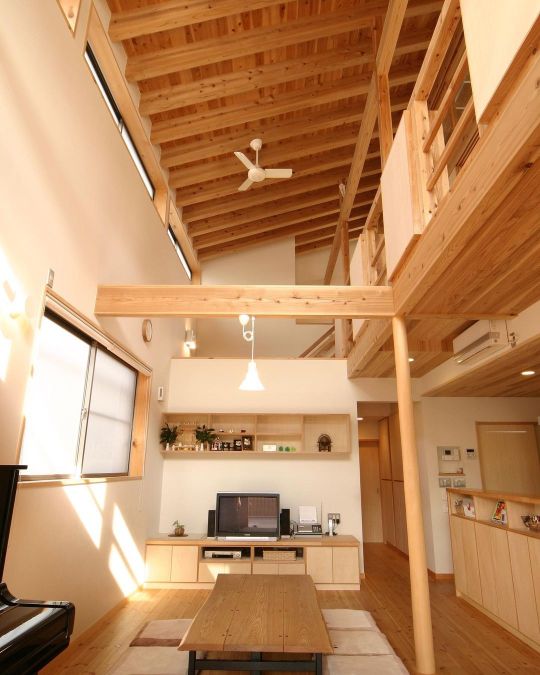
おはようございます。 岩倉の家|2005 愛知県岩倉市 リビングの吹抜けを見る。 3枚目はリビングから続くウッドデッキテラス。 #吹抜けリビング #木の家 #青木昌則建築研究所 @mojaoki https://www.instagram.com/p/CoA-WWMSM1G/?igshid=NGJjMDIxMWI=
0 notes
Photo
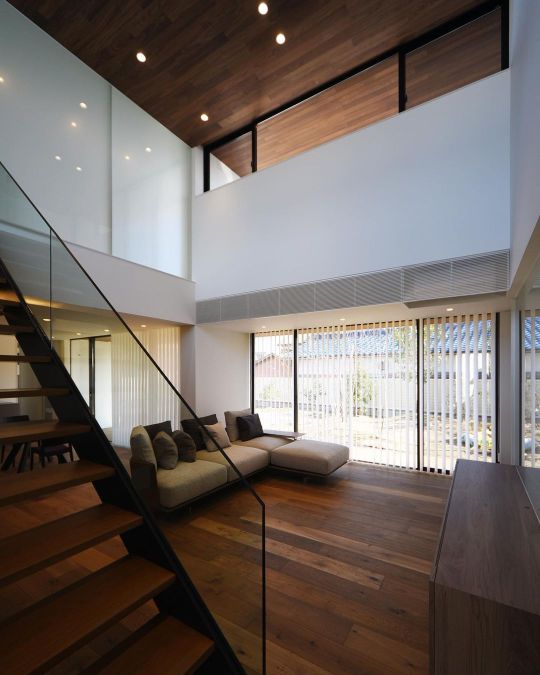
Thread design studio : Sat-house Photo : スレッドデザインITO スレッドデザインが、設計監理をさせていただいたダイナミックな吹抜けリビングのコンクリート造住宅です。 #スレッドデザインスタジオ #moderninterior #interiordesign #residence #名古屋設計事務所 #住宅設計 #住宅 #フローリング #二層吹き抜け #ハイサイドライト #芝生庭 #大開口 #板張り天井 #シンプルな住宅 #吹抜けリビング #バーチカルブラインド #ガラススクリーン #コンクリート #コンクリート造住宅 #ウッドデッキテラス #リビングからフラットに出られる https://www.instagram.com/p/CeZvvUgvcLw/?igshid=NGJjMDIxMWI=
#スレッドデザインスタジオ#moderninterior#interiordesign#residence#名古屋設計事務所#住宅設計#住宅#フローリング#二層吹き抜け#ハイサイドライト#芝生庭#大開口#板張り天井#シンプルな住宅#吹抜けリビング#バーチカルブラインド#ガラススクリーン#コンクリート#コンクリート造住宅#ウッドデッキテラス#リビングからフラットに出られる
0 notes
Photo

《#スキップフロア リビングから みえる風景》 スキップフロアからキッチン 2階の大空間 吹き抜けもあり、 開放感抜群!です😊 こだわりのカッコいい家は 高いですよね〜😅 #Repost @design_source_kamakura with @make_repost ・・・ : #吹抜けリビング から見る #キッチン と2階☻♡♬*゜ : #BROOKLYN_HOUSE ®︎ #相模原 #神奈川 : #住みたい家に住もう #brooklynhouse #designsource : ----------------------------------------- MORE PHOTOS…👉 @katojyukenfactory ----------------------------------------- . これから、お家を建てられる方 ご興味のある方は お気軽にお声掛けください☺️✨✨ . 💻オンライン相談も対応してます🙇♀️ . ⚒施工・diy【 @ksfactory_gifu 】 LINE公式アカウント【 @ks_style_house 】 📩お問い合わせ 【 @kj_contact 】 #岐阜工務店 #各務原工務店 #ヴィンテージインテリア #30坪二階建て #スキップフロアのある家 #新築 #住宅 #かっこいい家づくり #ブルックリンインテリア #建築 #マイホーム #ブルックリンスタイルの家 #男前インテリア #男前インテリア雑貨 #工務店 #モールテックス #morephoto #風景 #diy #リビング https://www.instagram.com/p/Cc7G8d4LfNi/?igshid=NGJjMDIxMWI=
#スキップフロア#repost#吹抜けリビング#キッチン#brooklyn_house#相模原#神奈川#住みたい家に住もう#brooklynhouse#designsource#岐阜工務店#各務原工務店#ヴィンテージインテリア#30坪二階建て#スキップフロアのある家#新築#住宅#かっこいい家づくり#ブルックリンインテリア#建築#マイホーム#ブルックリンスタイルの家#男前インテリア#男前インテリア雑貨#工務店#モールテックス#morephoto#風景#diy#リビング
0 notes
Photo

自邸の天井は落ち着く高さにしました 自分の好みもあって、結構オススメしています笑 背はギリギリ180cmないくらいですが ほぼ座って過ごしてるのもありますが 立っても全然大丈夫です オススメしたけど見ないと不安ということで 建築中に高さの実物を見てもらった時の 写真です◯ 落ち着く高さに抑えたおかげで 屋根なりに上げた天井がより高く感じます 良かったら、体感できるところを 探してみてください◯ 他にも色々な事例を紹介しているので @kazuya_ikezoi から見てみてください #低い天井 #エアコン隠し #エアコン隠しルーバー #吹き抜けリビング #吹き抜け #勾配天井 #勾配天井リビング #造作キッチン #造作カウンター #造作ダイニングテーブル #コの字型キッチン https://www.instagram.com/p/CqaTEUJvo4M/?igshid=NGJjMDIxMWI=
1 note
·
View note
Photo

工事中 まだまだ見れる!ちょっと触れる! 何層もスプレーして、スキン層を何枚も重ね合わせた、断熱材気密性能!【公式】 #みんなの見学大会 の一部 今朝の三枚おろし まな板の上、ラーチの天井(ダウンライト付き 階段、吊り戸棚等もだもんで)ってゆー 😍 #シティーボーイカントリー7 #おれんち風味 #おれんちフレーバー # #八幡平市産 #八幡平産 #メイドイン八幡平 #岩手県産 # #八幡平市 #二戸市 #一戸町 #滝沢市 #雫石町 #盛岡市 #岩手町 #盛岡 #雫石 # #ファースの家 #吹き抜け #吹き抜けリビング #吹き抜けのある家 #吹き抜け天井 #針葉樹合板 #節あり #構造用合板 #ラーチ #ラーチ合板 # (Hachimantai-shi, Iwate, Japan) https://www.instagram.com/p/Coo0-o5BnGX/?igshid=NGJjMDIxMWI=
#みんなの見学大会#シティーボーイカントリー7#おれんち風味#おれんちフレーバー#八幡平市産#八幡平産#メイドイン八幡平#岩手県産#八幡平市#二戸市#一戸町#滝沢市#雫石町#盛岡市#岩手町#盛岡#雫石#ファースの家#吹き抜け#吹き抜けリビング#吹き抜けのある家#吹き抜け天井#針葉樹合板#節あり#構造用合板#ラーチ#ラーチ合板
1 note
·
View note
Photo

#104薫風の家 本日無事に薫風の家はオーナーさまにお嫁入り しました😊 オーナー様から設計及びカーテン、家具、家電、全てに携わるという貴重な機会をいただきまして、ありがとうございました。 #設計事務所とつくる家 #設計事務所 #craftwork建築計画工房 #平家暮らし #吹き抜けリビング #格子のある家 #格子 #北欧 (株式会社Craftwork建築計画工房) https://www.instagram.com/p/Cl-4p5wSQqE/?igshid=NGJjMDIxMWI=
0 notes
Photo
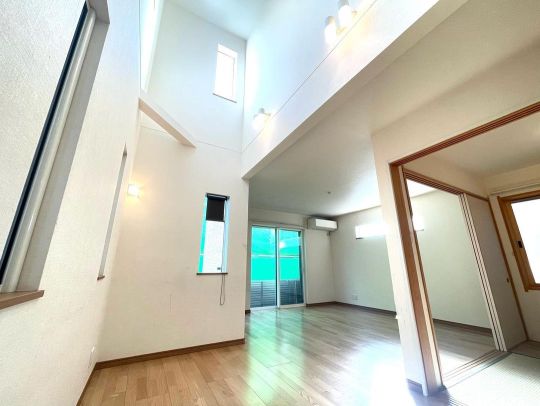
■LDK広々17.7帖!上部吹抜けで開放感ある住まい(^^♪ ■リビングは2箇所の床暖房付!冬も足元が温かく快適! ■追焚機能付オートバスや食洗機など快適な暮らしを彩る充実の設備! ■ウォークインクローゼットやパントリーなど収納も豊富(^^)/ ■戸建の特権!カースペース2台分あり! ■前面道路幅員約4.5mでお車の出し入れ楽々(^_-)-☆ お問い合わせはもちろん、その他ご質問等も大歓迎です。ぜひお気軽にスタッフにお問い合わせくださいませ。 物件概要 物件名 ピタットセレクション秋山 所在地 市川市稲越1丁目 交通 北総線「秋山」駅徒歩18分 土地面積 114.21m² 建物面積 99.05m² 間取り 4LDK 建物構造 木造2階建て 築年月 2015年6月築 間取り詳細 現況 空家 引渡時期 相談 土地権利 所有権 都市計画 市街化区域 地目 宅地 用途地域1 第一種低層住居専用地域 建ぺい率1/容積率1 50%/100% 建ぺい率2/容積率2 / 取引態様 媒介 接道状況 一方 小学校区 小学校区:市川市立稲越小学校 距離:1100m 中学校区 中学校区:市川市立東国分中学校 距離:1600m 設備 都市ガス 公営水道 排水(浄化槽) #市川市 #市川市戸建て #市川市稲越 #秋山駅 #秋山駅徒歩18分 #4LDK #吹き抜けリビング #駐車場2台 #不動産 #不動産業 #不動産仲介 #不動産仲介業 #不動産売買 #不動産相談 #不動産購入 #マイホーム #マイホーム計画 #マイホーム購入 #マイホーム計画中の人と繋がりたい #マイホーム検討中の方と繋がりたい #店舗駐車場あり #松戸不動産 #ピタットハウス #ピタットハウス松戸 #ピタットハウス松戸6号店 https://www.instagram.com/p/Ck7iVhaLWD1/?igshid=NGJjMDIxMWI=
#市川市#市川市戸建て#市川市稲越#秋山駅#秋山駅徒歩18分#4ldk#吹き抜けリビング#駐車場2台#不動産#不動産業#不動産仲介#不動産仲介業#不動産売買#不動産相談#不動産購入#マイホーム#マイホーム計画#マイホーム購入#マイホーム計画中の人と繋がりたい#マイホーム検討中の方と繋がりたい#店舗駐車場あり#松戸不動産#ピタットハウス#ピタットハウス松戸#ピタットハウス松戸6号店
0 notes
Photo
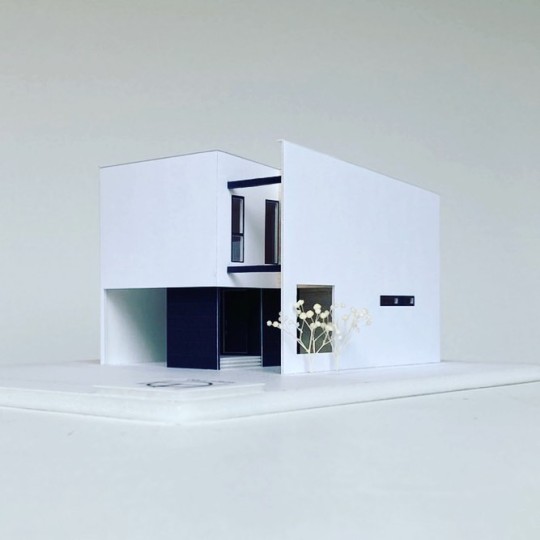
フローティングガーデンハウス #浮庭 #浮庭の家 #吹抜け #中庭 #ガーデン #ガーデンテラス #テラスハウス #2階リビング #ガレージ #ビルトインガレージ #BBQ #バーベキュー #バーベキューテラス #バルコニー #インナーバルコニー #住宅 #住宅設計 #デザイン #デザイン住宅 #建築家 #建築士 #設計士 #建築事務所 #設計事務所 #建築設計事務所 #一級建築士 #一級建築士事務所 https://www.instagram.com/p/CjiAkWoPbZT/?igshid=NGJjMDIxMWI=
#浮庭#浮庭の家#吹抜け#中庭#ガーデン#ガーデンテラス#テラスハウス#2階リビング#ガレージ#ビルトインガレージ#bbq#バーベキュー#バーベキューテラス#バルコニー#インナーバルコニー#住宅#住宅設計#デザイン#デザイン住宅#建築家#建築士#設計士#建築事務所#設計事務所#建築設計事務所#一級建築士#一級建築士事務所
0 notes
Text

House in Shukugawa
ミニマルな空間と美しい曲線が生む 優しく包容力のある住まい
The minimalist space and beautiful curves create a tender and inclusive home
夙川の家は兵庫県西宮市に位置し、四方を2階建て隣家に囲まれた旗竿型のコンパクトな敷地にあります。
プライバシーの観点から外側に開くことが難しい敷地条件であったため、内側にクライアントのための独立した世界をつくることを目指しました。
“大きな気積をもったドーム”と“適度に求心性のある平面”によって空間に包容力を持たせることで、閉じた箱の中でも窮屈さを感じることなく、美しい緑や光を愛でながら心地良く過ごせる住まいを計画しました。
“House in Shukugawa” is located in Nishinomiya City, Hyogo Prefecture, on a compact flagpole-shaped lot surrounded on all sides by two-story neighboring houses.
The site conditions made it difficult to open the house to the outside for privacy reasons, so we aimed to create an independent world for the client on the inside.
The "moderately centripetal plane" and the "dome with a large volume" give the space an inclusive feeling, so that even in a closed box, the client does not feel cramped, but can enjoy the beautiful greenery and light while living comfortably. The house was designed to be comfortable while loving beautiful greenery and light, without feeling cramped in a closed box.
-
⚪︎ロケーション
立地は兵庫県西宮市。周辺は自然が豊かで古くからの邸宅街が広がる夙川沿岸の閑静なエリア。地価が高く坪単価も比較的高いため、土地が細分化され密集している地域も多くみられる。 敷地はそのような地域の旗竿型のコンパクトな土地であり、四方を2階建て隣家に囲まれた窮屈な印象があった。クライアントは、周辺環境の良さと幼い頃から慣れ親しんだ地域であるという点を重視しこの土地を購入された。
⚪︎要望
クライアントから伺った理想の住環境や要望は、次の5つに整理できる。
自然とのつながり(緑、光、風、四季を感じれること)
プライバシーを確保しつつhyggeを大切にできること(hygge:デンマーク語で「居心地がいい空間」や「楽しい時間」をさす言葉)
陰翳礼讃の精神で光や陰翳を繊細に感じられること、照明計画にも変化や緩急があること
空間の多様性、ボリュームのメリハリ
普遍性のあるデザイン
⚪︎デザインコンセプト
プライバシーの観点から外側に開くことが難しい敷地条件であったため、内側にクライアントのための独立した世界をつくることを目指した。共有していただいた好みのインテリアイメージにはヨーロッパの空気感を感じるものが多く、意匠にもそれらの要素を取り入れることにした。
まず敷地に対して可能な限り大きく建物のフットプリントを設定し、外に閉じた箱型の計画とした。内部でも自然や四季を感じ取れるよう、比較的採光が確保しやすい北側の角に中庭を配置。その周りにリビングダイニングやキッチンなどのアクティブスペースを設けた。寝室や浴室といった個人の休息スペースは、必要最小限の大きさにして2階に配置した。
この住まいの最大の特徴であるホールは、外に閉じた住まいの中で窮屈さを感じることなく、家族や親しい人達と親密な時間を過ごせる空間を目指したものである。適度に求心性のある平面が団欒を生み、ドームの大きな気積により人が集まっても居心地の良さを担保できる。暮らしを受け止める包容力のある空間となっている。
さらに完全にプライベートな空間である2階に対して、1階は住宅でありながらセミパブリックな空気感を持たせることで、狭い箱の中に変化と奥行きを生み出そうとしている。床のタイル仕上げ、路地のテラス席のようなダイニングテーブル、吹き抜けに突き出したバルコニーのような踊り場、ドームとシンボリックなトップライトが醸し出す少し厳かな雰囲気、などの要素が相まって1階の空気感をつくり出している。
採光については、単に明るいことだけではなく相対的に明るさを感じられることも重要である。ホールの開口部は最小限として全体の照度を下げつつ、中庭に落ちる光が最大限美しく感じられるように明るさの序列を整理した。また壁天井の仕上げは淡い赤褐色の漆喰塗りに統一することで、明るさを増幅させながら光の暖かさも感じられるようにした。
空間操作としては、中庭外壁隅部のR加工、シームレスな左官仕上げとしたドーム天井、ドームと対照的に低く抑えた1階天井高などが距離感の錯覚を起こし、コンパクトな空間に視覚的な広がりをもたらしている。
⚪︎構造計画
木造軸組構法の構造材には、強度が高いことで知られる高知県産の土佐材を使用。上部躯体には土佐杉、土台にはより強度や耐久性の高い土佐桧を用いた。工務店が高知県から直接仕入れるこだわりの材であり、安定した品質の確保とコスト削減につながっている。
⚪︎造園計画
この住まいにおける重要な要素である中庭は、光や風を映し出す雑木による設え。苔やシダなどの下草から景石や中高木まで、複数のレイヤーを重ね、コンパクトでありながらも奥行きのある風景をつくり出している。またコンパクトな分植物と人との距離が近く、天候や四季の移ろいを生活の中で身近に感じ取ることができる。石畳となっているため、気候の良い時期は気軽に外へ出て軽食を取るなど、テラスのような使い方も可能。草木を愛でる豊かさを生活に取り入れてもらえることを目指した。
敷地のアプローチ部分には錆御影石を乱張りし、大胆にも室内の玄関土間まで引き込んで連続させている。隣地に挟まれた狭い通路であるため、訪れる人に奥への期待感を抱かせるような手の込んだ仕上げとした。また石敷きを採用することにより来訪者の意識が足元に向かい、ホール吹抜けの開放感を演出する一助となっている。
⚪︎照明計画
ベース照明は、明るすぎず器具自体の存在感を極力感じさせない配置を心掛けた。特に中庭の植栽を引き立てる照明は、月明かりのように高い位置から照射することで、ガラスへの映り込みを防止しつつ、植物の自然な美しさを表現できるよう配慮している。ホールについても、空間の抽象度を損なわないために、エアコンのニッチ内にアッパーライトを仕込み、天井面に器具が露出することを避けた。
対して、人を迎え入れたり留まらせる場(玄関、ダイニング、リビング、トイレ)には、質感のある存在感をもった照明を配置し、インテリアに寄与するとともに空間のアクセントとしている。
⚪︎室内環境
居心地のよい空間をつくるためには快適な温熱環境も不可欠である。建物全体がコンパクト且つ緩やかに繋がっているため、冬季は1階ホールとキッチンに設置した床暖房によって、効率よく建物全体を温めることができる。壁天井には全体を通して漆喰(マーブルフィール)による左官仕上げを採用し、建物自体の調湿性能を高めている。
換気設備は「第1種換気※1」を採用。温度交換効率92%の全熱交換型換気ファン(オンダレス)により、給排気の際に室内の温度と湿度を損なうことなく換気を行うことができるため、快適で冷暖房負荷の削減に繋がる。CO2濃度や湿度をセンサーにより検知し、自動で換気量を増やす仕組みも取り入れている。
また断熱材は、一般的なボードタイプよ��も気密性が高く、透湿性に優れた木造用の吹き付けタイプを使用。サッシはLow-E複層ガラス+アルゴンガス充填で断熱性を高めた。
※1「第1種換気」..給気、排気ともに機械換気装置によって行う換気方法
⚪︎まとめ
近隣住宅が密集する環境の中で、周囲を隔てて内部空間を切り離すことで、住み手のための世界を築くことができた。仕事で毎日を忙しく過ごすクライアントだが、ここでの時間は、仕事を忘れ、好きなものに囲まれ、家族や友人たちと心から安らげる時を過ごしてほしい。心身共に癒やされるような家での日常が、日々の活力となるように。この住まいがそんな生活を支える器になることを願っている。
⚪︎建物概要
家族構成 |夫婦
延床面積 |70.10㎡
建築面積 |42.56㎡
1階床面積|39.59㎡
2階床面積|30.51㎡
所在地 |兵庫県西宮市
用途地域 |22条区域
構造規模 |木造2階建て
外部仕上 |外壁:小波ガルバリウム鋼板貼り、ジョリパッド吹付
内部仕上 |床:タイル貼、複合フローリング貼
壁:マーブルフィール塗装仕上
天井:マーブルフィール塗装仕上
設計期間|2022年11月~2023年7月
工事期間|2023年8月~2024年3月
基本設計・実施設計・現場監理|
arbol 堤 庸策 + アシタカ建築設計室 加藤 鷹
施工 |株式会社稔工務店
造園 |荻野景観設計株式会社
照明 |大光電機株式会社 花井 架津彦
空調 |ジェイベック株式会社 高田 英克
家具制作|ダイニングテーブル、ソファ:wood work olior.
ダイニングチェア:tenon
インテリアスタイリング|raum
撮影 |下村写真事務所 下村 康典 、加藤 鷹
資金計画・土地探し・住宅ローン選び|株式会社ハウス・ブリッジ
テキスト|加藤 鷹
-
House in Shukugawa
⚪︎Positioning the land as the background
Located in Nishinomiya City, Hyogo Prefecture, the surroundings along the Shukugawa River are quiet, with abundant nature and a long-established residential area. Due to the high value of land and the relatively high unit price per tsubo, there are many areas where land is densely subdivided into smaller lots.
The site was a compact, flagpole-shaped lot surrounded on all sides by two-story neighboring houses. These conditions were by no means good. However, the client purchased the lot because of its good surrounding environment and the fact that it was in an area that he had grown familiar with since childhood.
⚪︎Requests
The ideal living conditions and requests we recieved from the client can be organized into the following five categories.
To be able to feel nature (greenery, light, wind) and the four seasons (change of time) even inside the house.
To be able to cherish hygge (Danish word meaning "comfortable space" or "enjoyable time") while ensuring privacy.
The spirit of "In Praise of Shadows" should be valued, and changes in shadows and ambient light should be sensed with subtlety. The lighting scheme should not be uniformly bright, but varied and gradual.
The entire space should be loosely connected, but with a variety of spatial volumes to suit different uses.
The design should have a universality that will allow the owner to enjoy the house, from the interior to the exterior, for a long time.
Based on these themes and the site conditions, the architectural form was studied.
⚪︎Design concept
The site conditions made it difficult to open the house to the outside for privacy reasons, so we aimed to create an independent world within the house in line with the client's preferences. Many of the interior images they shared with us had a European feel, and we decided to incorporate these elements into the design.
First, the footprint of the building was set as large as possible in relation to the site, and it was designed to be boxy and closed to the outside. To allow the interior to experience nature and the four seasons, a courtyard was placed in the north corner, where it is relatively easy to secure lighting. The hall (living and dining room), kitchen, and other active spaces are located around the courtyard. Rooms for individual rest, such as bedrooms and bathrooms, were kept to the minimum necessary size and placed on the second floor. (The storage furniture in the bedroom is movable in order to accommodate changes in usage.)
The hall, the most distinctive feature of this house, was intended to be a space that gently envelops time with family and close friends without feeling cramped in a house closed to the outside. The hall has a moderately centripetal plane that creates a sense of harmony, and a large dome-shaped volume that ensures a cozy atmosphere even when people gather together, giving the space a sense of inclusiveness.
In contrast to the completely private space on the second floor, the first floor has a semi-public atmosphere even though it is a house, creating a sense of change and depth within the narrow box. The tiled floor, the dining table that resembles a terrace in an alley, the balcony-like landing that protrudes into the atrium, and the slightly austere atmosphere created by the dome and symbolic top light all work together to create the atmosphere of the ground floor.
In terms of lighting, it is important not only to have brightness, but also to have a sense of relative brightness. While minimizing the openings in the hall to lower the overall illumination level, we organized the sequence of brightness so that the light falling on the courtyard would be perceived as beautiful as possible. The walls and ceiling are finished in a uniform light reddish-brown plaster, which allows the warmth of the light to be felt while amplifying the brightness of the space.
In terms of spatial manipulation, the soft curvature of the outer courtyard wall corners, the seamless plastered dome ceiling, and the low ceiling height of the first floor in contrast to the dome create the illusion of distance and visual expansion in a compact space.
⚪︎Interior Environment
A comfortable thermal environment is also essential for creating a cozy space. As the entire building is compact and gently connected, the volume can be efficiently heated in winter by floor heating installed in the ground-floor hall and kitchen. The walls and ceilings are plastered (with a Marble Feel) throughout to enhance the building's own humidity control.
The ventilation system is "Class 1 Ventilation*1. The ventilation system uses a total heat exchange type ventilation fan (ondaless) with a temperature exchange efficiency of 92%, which allows ventilation without compromising indoor temperature and humidity during air supply and exhaust, resulting in comfort and reduced heating and cooling loads.
The insulation is of the sprayed wooden type, which is more airtight and has better moisture permeability than ordinary board-type insulation. Low-E double-glazing glass with an argon gas filling are used to enhance thermal insulation.
*1 "Type 1 Ventilation". A ventilation method in which both air supply and exhaust are done by a mechanical ventilator.
⚪︎Structural Planning
Tosa wood from Kochi Prefecture known for its high strength, were used for the structural members of the wooden frame. Tosa cedar was used for the upper frame, and Tosa cypress was used for the foundation because of its higher strength and durability. The construction company purchased these materials directly from Kochi Prefecture, ensuring stable quality and reducing costs.
⚪︎Landscaping plan
The courtyard, an important element of the house, is designed with a mix of trees that reflect the light and wind. Multiple layers, from undergrowth such as moss and ferns to landscape stones and medium height trees, create a compact yet deep landscape. The compactness of the space also means that the plants are close to people, allowing the users to feel the weather and the changing seasons in their daily lives. The cobblestone pavement enables the use of a terrace-like space, where one can casually step outside for a light meal when the weather is nice. We aimed to bring the richness of loving plants and trees into people's lives.
The approach to the site is made up of tan-brown granite, which is boldly pulled into the entrance floor of the house to create a continuous line. Since it is a narrow passageway between neighboring properties, we created an elaborate finish to give visitors a sense of anticipation of what lies ahead. The use of stone paving also directs visitors' attention to their feet, helping to create a sense of openness in the hall atrium.
⚪︎Lighting Plan
The base lighting is not too bright, and the presence of the fixtures themselves is minimized as much as possible. In particular, the lighting that enhances the plants in the courtyard illuminates from a high position, like moonlight, to prevent reflections on the glass and to express the natural beauty of the plants. In the hall, lights were installed in the air conditioner niche avoiding the exposure of fixtures on the ceiling surface, so as not to spoil the abstractness of the space.
On the other hand, at the place where people are welcomed in or stay (entrance, dining room, living room, and restroom), lighting with a textured presence is placed to contribute to the interior design and accentuate the space.
⚪︎Summary
In an environment where neighboring houses are densely packed, we were able to build a world for the residents by separating the interior spaces from their surroundings. The client spends his busy days at work, but during his time here, he wants to forget his work, surround himself with his favorite things, and spend truly restful moments with his family and friends. We hope that daily life in a house that heals both body and soul will be a source of daily vitality. We hope that this home will be a vessel to support such a lifestyle.
⚪︎Property Information
Client|Couple
Total floor area|70.10m2
Building area|42.56m2
1floor area|39.59m2
2floor area|30.51m2
Location|Nishinomiya-shi, Hyogo, Japan
Zoning|Article 22 zone
Structure|Wooden 2 stories
Exterior|Galvalume steel sheet, sprayed with Jolipad
Interior|Floor: Tile flooring, composite flooring
Walls: Marble Feel paint finish
Ceiling: Marble Feel paint finish
Design Period|November 2022 - July 2023
Construction Period|August 2023 - March 2024
Basic Design/Execution Design/Site Supervision| Yosaku Tsutsumi, arbol + O Kato, Ashitaka Architect Atelier
Construction| Minoru Construction Company
Landscaping|Ogino Landscape Design Co.
Lighting|Kazuhiko Hanai, Daiko Electric Co.
Air Conditioning|Hidekatsu Takada, Jbeck Co.
Dining table and sofa|wood work olior.
Dining chairs|tenon
Interior styling|raum
Photography|Yasunori Shimomura, Shimomura Photo Office (partly by O Kato)
Financial planning, land search, mortgage selection|House-Bridge Co.
Text | O Kato
#architecture#architectdesign#design#インテリア#インテリアデザイン#buildings#furniture#home & lifestyle#interiors#夙川の家#住宅#住宅設計#建築#アシタカ建築設計室
8 notes
·
View notes
Text

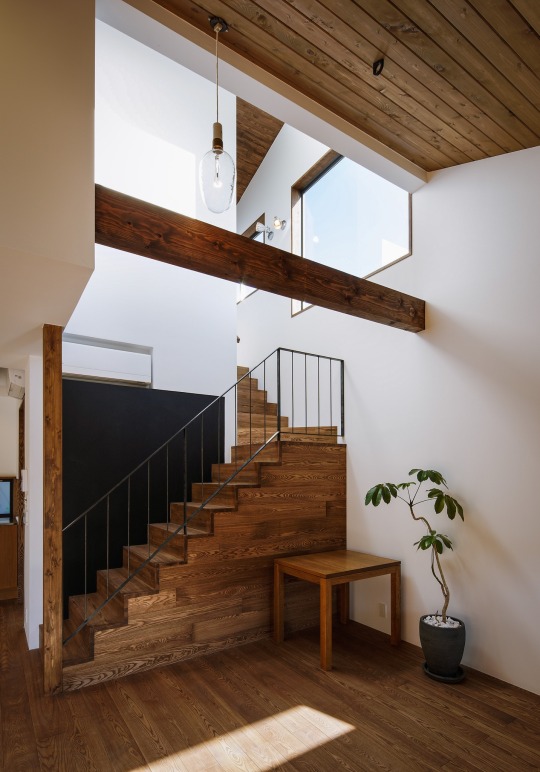
イカ釣りランプの吹抜けリビング♪
■haus-hat■
大阪府箕面市
#design#architecture#house#architect#設計事務所#建築#haus#建築家#インテリア#interior#一級建築士事務所haus#living room#japanese architecture#japanese style#living
226 notes
·
View notes
Photo

長野県原村のA-frame House🔺 内部に柱や梁の制約がほとんどないA-frame工法は、自由な形の吹き抜けを提案できます✨ #aframe #house #livingroom #interior #インテリア #リビング #自然素材の家 (原村) https://www.instagram.com/p/Cmq6yM7rQFh/?igshid=NGJjMDIxMWI=
3 notes
·
View notes
Photo

おはようございます。 岩倉の家|2005 愛知県岩倉市 吹抜けのある床座のリビング。 #吹抜けリビング #木の家 #青木昌則建築研究所 @mojaoki https://www.instagram.com/p/Cn-a8WkSN9a/?igshid=NGJjMDIxMWI=
0 notes
Photo

Thread design studio : Sat-house Photo : スレッドデザインITO スレッドデザインが、設計監理をさせていただいたダイナミックな吹抜けリビングのコンクリート造住宅です。 #スレッドデザインスタジオ #moderninterior #interiordesign #residence #名古屋設計事務所 #住宅設計 #住宅 #フローリング #二層吹き抜け #ハイサイドライト #芝生庭 #大開口 #板張り天井 #シンプルな住宅 #吹抜けリビング #バーチカルブラインド #ガラススクリーン #コンクリート #コンクリート造住宅 #ウッドデッキテラス #リビングからフラットに出られる https://www.instagram.com/p/CeU22wvryFX/?igshid=NGJjMDIxMWI=
#スレッドデザインスタジオ#moderninterior#interiordesign#residence#名古屋設計事務所#住宅設計#住宅#フローリング#二層吹き抜け#ハイサイドライト#芝生庭#大開口#板張り天井#シンプルな住宅#吹抜けリビング#バーチカルブラインド#ガラススクリーン#コンクリート#コンクリート造住宅#ウッドデッキテラス#リビングからフラットに出られる
0 notes
Photo
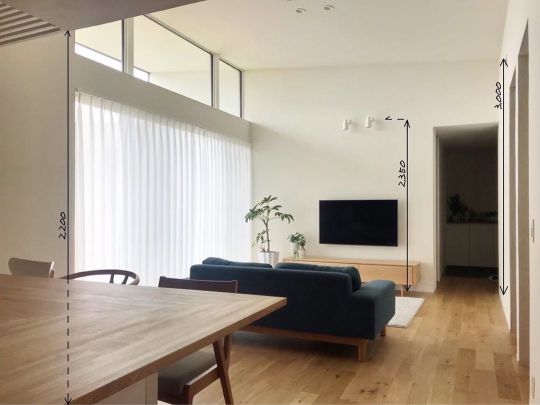
高さのメモ 自邸は基本の天井の高さを2.2mで計画 平屋のいいとこををつかって、リビングだけ 天井のふところ分、屋根なりに高さを上げました 緩やかに上がってますが、低いところで約3mです 高さだったり明るさや色等もそうですが 高低差や明暗差のような、何かとの比較で より感じられるようになります 他にも事例を紹介しているので @kazuya_ikezoi からとんで見てください #吹き抜けリビング #勾配天井 #造作ダイニング #コの字キッチン #コの字型キッチン #フルハイトドア #壁掛けテレビ #テレビボード #ハイサイド #ハイサイドライト #吹き抜け窓 #吹き抜け照明 #ブラケットライト #ブラケット照明 #設計士とつくる家 #コラボハウス https://www.instagram.com/p/Cp489auPNMh/?igshid=NGJjMDIxMWI=
#吹き抜けリビング#勾配天井#造作ダイニング#コの字キッチン#コの字型キッチン#フルハイトドア#壁掛けテレビ#テレビボード#ハイサイド#ハイサイドライト#吹き抜け窓#吹き抜け照明#ブラケットライト#ブラケット照明#設計士とつくる家#コラボハウス
0 notes
Text
富士見台の家2022

長野県上田市の住宅「上田市・富士見台の家2022」です。
2022年2月に竣工しました。

日当たりの良いリビング
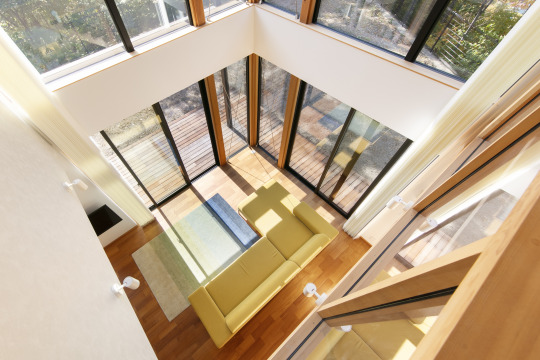
吹抜け上からリビングをみる
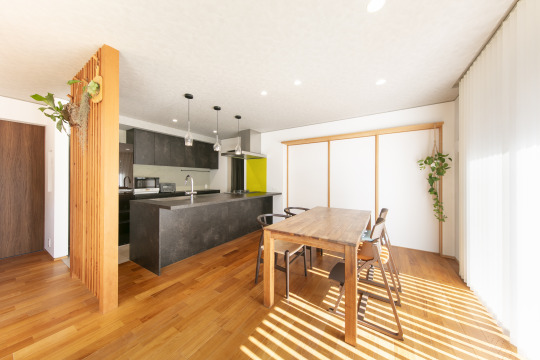
ダイニングキッチン

ダイニングからリビングをみる

和室
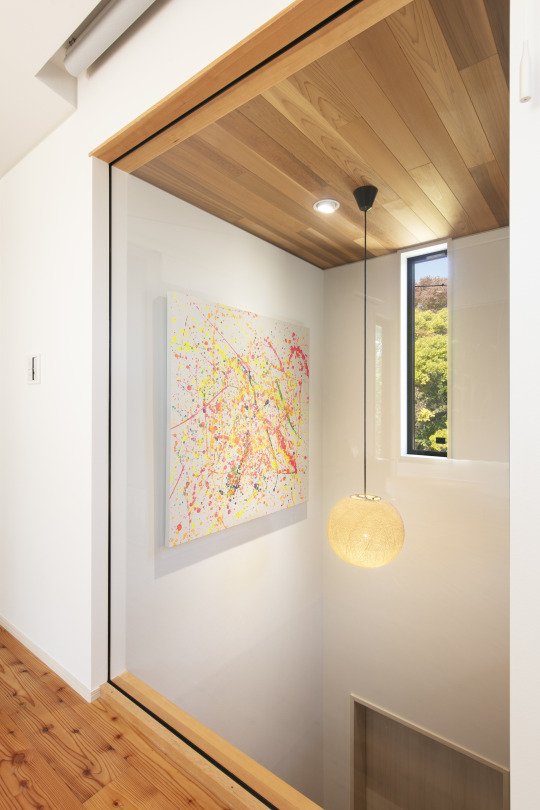
玄関ホールの吹抜け

東側外観 夕景
【DATA】
延床面積 129.27㎡
構造 木造
規模 2階建て
設計・監理:菊池ひろ建築設計室
撮影:archipicture 遠山功太
0 notes
Text
シロクマハウスについての6つの文章
--------------------------------------------------
[テキスト]
シロクマハウス:たとえば6つの解釈
■1.住宅としての解釈
■2.構造からの解釈
■3.生態的な解釈
■4.形式への解釈
■5.コーリン・ロウ風の解釈
■6.音楽としての解釈
■1.住宅としての解釈
シロクマハウスの住人は、むかしから慣れ親しんだ実家の土地に新しく家を建て住まうことを決めました。建てた家は、折しもウッドショックや戦争の影響による資材高騰があり、また雪国特有の条例(建物外壁は隣地から1m以上の離れが必要なこと)などから、敷地に対してとてもコンパクトな立方体形状の家となりました。
全体の構成は、一辺が2.3mの立方体を8つ、それぞれ95cmずつ、外側は30cmずつ離して配置した、全体6.15mの立方体を基本としています。この立方体は敷地に収まる最大の容積を根拠に大きさを決めたため、人間のスケールや生活を根拠にしたものではありません。
この立方体を「建築」と仮託して、そこに土地の状��や生活の観点から、〈明るい場所〉〈暗い場所〉〈大きな場所〉〈小さな場所〉を住まい手とともに見極め、想像しながら「暮らし」として意味付けをしていきました。「建築」に「暮らし」を見出していくなかで注意したのが〈リビング〉や〈ダイニング〉などの言葉で使い方と場所を結びつけない、ということでした。明るくて爽やかな場所、大きくてふわっと明るい場所、小さくてしんと暗い場所、などを見つけながら、でも、意味を付けすぎないように、という作業を根気強くつづけました。吹抜けのある大きな場所は朝食を食べてもいいし、一段上がったキッチン横の場所は夕食が合うかもしれない。浴槽のある場所はいちばん明るくて爽やかな場所なので、そこで読書しても気持ちよさそうです。立方体の組み合わせによる単純な「建築」に対して「暮らし」が応答して出来上がったかたちは、とても複雑で多様な場所を生みました。
建物として家は完成しましたが、ここから住まい手自身が愛着をもって意味付けをしていければ、そこは唯一無二の大切な〈わが家〉になっていくでしょう。その意味付けのきっかけは〈他と少し違う外観〉かもしれないし、〈壁の手触り〉かもしれないし、〈台所の音〉や、あるいは〈匂い〉かもしれません。柱梁がむきだしの部分、段々に角がある部分、ざらざらした部分、つるつるした部分など、いまはまだよくわからないかたちにも、暮らしていくなかでその都度、意味を見出しながら使いこなして〈わが家〉にしていく、そういった主体的な暮らしの準備ができたと思います。
■2.構造からの解釈
モノの流通が滞り、普通にあったものが手に入らなくなったり、高くなったりしている昨今、建物の材料や作り方を再考する必要性が生じています。このプロジェクトは北海道という土地柄、早くから構造材の四寸(120 mm幅)シリーズが品薄となっていたこともあり、一番手に入りやすくて安価な「三寸五分の正角材(105 mm×105 mm)のみの構造」、そして施工業者を選ばない「最低限の技術レベルでの組み立て」、その結果として「構造にかかるコストを最小にすること」は、今を反映した一つのプロトタイプになりえるのではないかと考えました。
プランは 2.3mを最大スパンとしているため、軸力も小さく柱は105 mm角で問題ありません。ただ、曲げがかかる梁ではそれでは役不足なので、柱を結ぶ大梁の位置では逆V字の斜材を上下の梁材の間に入れることによりトラス効果で床荷重を支持することとしました。
大梁で囲まれた2.3m角の床面は、通常のように一方向に小梁を流すと四周の大梁に均等に力が流れず、その負担分に差が出ます。そこで、力の方向性をなくすこと、スパンを減らすこと、トラスの斜材に直に力を流すこと、の3つの理由から火打ち梁のようにダイヤ型に梁を配置しています。
基本的には木造在来軸組み工法なので、簡易な構造といえます。トラス梁部分は少しイレギュラーですが、斜材端部は梁にその一部を差し込むことで、離れ止めのボルトのみで緊結するというシンプルなものです。このように特別な金物を使わないことは製作および現場施工を容易にし、コストも下げられます。
(文:正木構造研究所:正木健太さん)
■3.生態的な解釈
[ベルクマン・アレンの法則]
「ベルクマンの法則」とは、ドイツの生物学者ベルクマンが発表した法則で、恒温動物について、同じ種でも寒冷な地域に生息するものほど体が大きいという法則です。例えば熊は、マレー熊など南方の熊は体が小さく、ホッキョクグマなど北方の熊は体が大きい傾向にあります。また反対に「アレンの法則」とは、恒温動物について、寒冷な地域に生息するものほど耳や尾などの突出部が短くなるというものです。ホッキョクグマの小さな耳はこの法則にのっとっているそうです。
さて、札幌の住宅を眺めると大抵どれも大きく箱型で、かつ、陸屋根というかたちをしています。これは東京などの都心部とは異なる土地事情によって一軒あたりの土地面積が比較的大きいこと、積雪に対しては落雪させずにスノーダクトを用いて雪を処理すること、などの要因が大きく関係していることはすぐに想像できるのですが、ここに「ベルクマン・アレンの法則」が見いだせるのではないかとも思っています。
あらためていまの札幌の住宅を眺めてみると、庇も少なく勾配屋根もあまり見られません。また外壁の凹凸も比較的少ない傾向に見えます。一方、建物全体のボリュームは都内の狭小住宅などに比べると、ひとまわり、ふたまわり、大きいような印象があります。つまり、突出部が小さく、かつ、その表面積に比べて体積が大きい、ホッキョクグマの体のような傾向がなんとなく見えてきます。
「ベルクマン・アレンの法則」は放熱の問題で説明されます。つまり、表面積に比べて体積を大きくすることは、体内の熱生産量に比べて放熱量を小さくする工夫だというのです。シロクマハウスの胴体にあたる立方体は球に次いで表面積の小さなかたちです。シロクマハウスは中心の大きな立方体をメインに、その少し外側に付加断熱を加えた外壁が「毛皮」のように取り巻き、また、生活に必要な玄関や納戸などの非居室が「鼻」や「尻尾」のようにくっついたかたちをしています。
この建物を設計していくなかで、なんとなく通称として仮に呼びはじめ、なんとなくしっくりきている〈シロクマハウス〉という名前は、このような北国の生き物、建物、の立ちあらわれ方を象徴しているようにも思えます。
■4.形式への解釈
[一辺が6.15mの立方体が与えられたとする]
「立方体」というのは公理に非常に近く、証明しようのない、根拠の無い、論理式に近いかたちです。いってしまえば、とても意味の無い、無意味なかたちともいえます。
四角い箱にはおおむね作られる意味があります。中にリンゴを入れるため、あるいは人が上に乗るため、など、いろんな意味のために四角というかたちをつかって箱は作られます。でも、四角というかたち自体に意味をつけることは、実は難しかったりします。四角がなぜ四角なのか、いろいろと意味を付けてみても、それら全部が上滑りしてしまうのが純粋な幾何学のかたちの不思議なところだと思います。むかしから四角いかたちの造形物(モノリス)が、異様な、未来からのものに見えたり、過去世界の遺物に見えたり、別世界のものにみえたりするのは、その純粋幾何学のかたちの無根拠さゆえかもしれません。
一方で、世界のありとあらゆるものをどのように意味付けて解釈するかは私たち人間に任されています。あらゆるものに意味をつけて世界を存在させること、それが私たちの主体性であって自律性でもあります。しばしば建築家によって〈自律的な建築〉とか〈他律的な建築〉とかいった言葉がつかわれますが、それは結局、ある人からはそう見える、というくらいのことなのかもしれません。建築自体の自律性や他律性を考えるのも面白いのですが、人間として主体的によく生きたいという、より根本的なものを目標にすれば、建築を含めたこの世界を意味付ける、人間の自律性の方がはるかに重要なものに思えます。
たとえば住まいをつくろうと考えたとします。たとえば住みたい場所が寒い地域だったとします。そういったなんとなく与条件として意味付けられるものたちと、立方体のような、あからさまに根拠が無くて、意味のよく分からないものを、同列に並べてみましょう。それらをあらためて自ら意味付け、解釈しようとするところに、私たち、設計者や住まい手の主体性や自律性は自覚されて、自分が置かれた環境を積極的に肯定していく人間的な暮らしにつながっていくのではないでしょうか。
■5.コーリン・ロウ風の解釈
[理想的ヴィラの数学]
「この住宅は立体の表象であるという観念が実現されるとき、ヴェルギリウスの夢という意図も果たされるのである。ここには絶対的なるものと偶然的なるもの、抽象と自然の衝突があり、理想世界とあまりに人間的な現実の急務とのギャップが悲哀に満ちて示されている。」
コーリン・ロウ『マニエリスムと近代建築』(伊東豊雄、松永安光訳、彰国社、1981年)より。
この住宅は、前後に付加された勾配屋根のヴォリュームを除けば、基本的なヴォリュームは 1 対 1 対 1 の立方体である。平面の構成は、中央の柱間を 1 とすると、前から後へおよそ 1/3 対 1+√2 対 1 対 1+√2 対 1/3 の比で進む。この比の構成は左右方向についても、また垂直方向についても徹底して保たれている。中央部のスパンに対して中間部のスパンが白銀比に近似している点は日本的比例の美学というよりは偶然的なものであろうが、その膨張した中間部のスパンに対して外周部のスパンが極端に圧縮されることによって、関心は中央から中間部へと移されることになる。3軸に同じ比が徹底されることによって中間部には 1+√2 の立方体が8つ現れており、それぞれの中心に重心が等しく置かれていることが暗示される。この住宅では3軸のシンメトリー 構成の中で、中央部への集中でもなく、周縁への離散でもなく、中間部において複数の中心の遍在というものが強調される。
この3軸が等しくシンメトリーな構成の中で、なおも上下左右を等しく相対化しようという試みに、床や壁、柱や梁といった構造も参加する。中央右手では吹抜けに面して2層をまたぐ壁面が垂直性を強調する一方、2層目左では同じ大きさの床面が水平性を強調している。柱や梁は同じ太さで縦横に現れ、重力の存���を示唆するのは二段梁の間を繋ぐ山形の方杖のみである。こうして通常、重力に基づいて積み上げられる壁・柱の垂直性や床の水平性は、ここでは解体され、立方体の6面すべてに均等な重要性が割り当てられることになるのである。均等に重力を与えられた6面は、離散することなく幾何学的配置にその中心を留め全体を構成する。
このように集中的なヒエラルキーを排しつつも離散を避けようとするどっちつかずの態度は、恐らく、多様な中心の遍在を認めるリゾーム的世界観によるものであろう。多様化した社会において、ある建物を住宅たらしめるのは行為として表現される暮らしそのものであり、慣習に拠る美を持ち込み、継承し、再生産し続ける「文字以前の文字(プロ・グラム)」である。一方、この住宅の理論は一種のポストモダンであり、過去の客観的美学=数学的規範を持ち込みつつ、それによって過去の構築を相対化し、集中と離散の二項対立を脱構築しようとする分裂的な試みである。そしてプロ・グラムと衝突するこの理論こそ、普遍的な生き生きとした力を喚起する幾何学なのである。
■6.音楽としての解釈
[マイルス・デイビス]
「非常にわかりやすい、見え見えなぐらいな部分と、全く意味不明の謎の部分というのが、丁度半分半分混じっていく、というのが、マイルス・デイビスの音楽であり、人となりであり、パッションであり、あらゆる彼の行動規範に張り付いているアンビバレンスです。」ジャズ・ミュージシャンの菊地成孔さんはマイルス・デイビスをこのように解説しました。
マイルスによって完成された「モード・ジャズ」は、それまでのコード進行によるモダン・ジャズとは異なり、「モード」と呼ばれる音階内でのアドリブを特徴とするものなのだそうです。それまでのジャズの歴史でどんどん複雑化していたコード進行を極端に単純化したうえで、モードによってより自由な演奏を可能にしました。モードとは、西洋音楽の音階とは異なる音階、日本のヨナ抜き音階や、琉球音階、インドネシアのガムラン音階など、土着的で民族的なものを指し、マイルスはカリンバのアフリカ的な音階に出会ってモード・ジャズを完成させたともいわれます。おおむね7つの音で構成されるモードと、それを用いたモード・ジャズについて、菊池成孔さんは「少ない音、7つだけの音で自由に演奏しろと言われた場合はですね、自由度が高すぎてサウンドの審美眼とかセンスが露骨に出るので、非常に難しい、」と解説します。
シロクマハウスも、もしかするとそのモード・ジャズ、あるいはマイルス・デイビスのように解釈することができるかもしれません。シロクマハウスは、8つの立方体の間に95cm幅のスリットをたてよこ水平に入れるという「非常にわかりやすい見え見え」な構成ですが、その構成の根拠は恣意的かつ薄弱で「意味不明」でもあります。一方で、暮らしによって立ちあらわれている壁や窓や棚などの部分は、意味としては「見え見え」ですが、複雑で過剰なその全体のかたちは「意味不明」でもあります。
つまりシロクマハウスは、あからさまに単純な構成を〈コード〉とし、北海道という土地や社会などの〈モード〉のなかで、設計者の恣意性や手癖・住まい手の趣味や暮らしによる〈アドリブ〉が行われる、そんなモード・ジャズ、という見方ができるかもしれません。そしてそれは、意味とあらわれのアンビバレンスが振動するようなグルーヴを生んでいくのかもしれません。
--------------------------------------------------
[Text]
Six Interpretations of the house “Polar bear”, for example
1. Interpretation as a HOUSE
2. Interpretation from STRUCTURAL engineering
3. Interpretation from ECOLOGICAL point of view
4. Interpretation in terms of FORM
5. Interpretation in the style of Colin Rowe
6. Interpretation as MUSIC
1. Interpretation as a HOUSE
The owner of this house decided to build a new house on a site in Hokkaido, which he had grown accustomed to living in since long ago. The house was built in a very compact cube form concerning the site, due to the rising cost of materials caused by the wood shock and the war, as well as a regulation unique to snow country (the building envelope must be at least 1 m away from the neighboring site). The overall composition is based on eight cubes of 2.3 meters on each side, 95 cm apart on each side, and 30 cm apart on the outside, for an overall cube of 6.15 meters. The size of this cube was defined based on the maximum volume that could fit on the site and is not based on human scale or traditional modules.
We considered this cube as "Architecture," and together with the owner and his family, we discovered and imagined "bright places," "dark places," "big places," "small places", etc. in terms of local conditions and lifestyles, and gave meaning to them as "living". In trying to give "Architecture" a meaning of "living," we were careful to avoid using generic terms such as "living room" or "dining room" to link behavior with place. We patiently continued our exploration, finding bright and breezy places, large and softly bright places, small and dark places, etc., without adding too much meaning to them. The large area with the atrium could be used for breakfast, and the area next to the kitchen, one step up, might suit dinner. The bathtub area is the brightest and most refreshing place, so it would be pleasant to read a book there. The resulting house, in which "living" responds to the plain "Architecture" of overlapping cubes, has generated a complex and diverse place.
The house as a building has been completed. However, the attachment of the owner and his family and the meaning they give to the house will make it a unique "home." The trigger for this attachment may be "the somewhat strange facade," "the hand feeling of the walls," "the sound of the kitchen," or even "the smells." The owner and his family are now ready to live with a sense of agency, finding meaning in forms that are not yet understandable, such as exposed pillars and beams, several intricate corners, rough and smooth surfaces, and so on, and using them to make the house his "home" while living in the house.
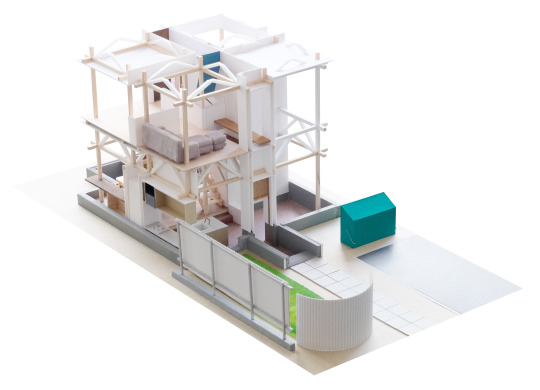
2. Interpretation from STRUCTURAL engineering
Recently, the distribution of goods tends to be stagnant, and what used to be commonplace has become unavailable or expensive, making it necessary to reconsider building materials and construction methods. Because of the location of this project in Hokkaido, where the 120 mm width series of structural timbers were in short supply from early on, we thought that "structure using only 105 mm x 105 mm structural timbers," which is the most accessible and inexpensive, and "construction at the minimum technical level" that does not require special contractors, and thus "minimizing the cost of the structure" could be a prototype that reflects the social situation of the present day.
The maximum span of the columns is 2.3 m, so the axial force is small, and 105 mm square columns are sufficient. However, this is not enough for beams that are subject to bending, so an inverted V-shaped diagonal timber was placed between the upper and lower beam members at the position of the girder connecting the columns to support the floor load with a truss effect. The 2.3m square floor is surrounded by girders, if the beams are placed in one direction as usual, the force will not flow evenly to the girders on all four sides, resulting in a difference in the amount of load. Therefore, the beams are placed in a diamond shape like a corner brace for three reasons: to nullify the direction of force, to shorten the span, and to flow the force directly to the truss members.
It can be said this is a simple structure because it is essentially a Japanese conventional post and beam structural system. The truss section is a bit irregular, but they are simply tied together by inserting a portion of the truss member into the beams and bolting them together. Thus, the absence of special hardware facilitates fabrication and construction, as well as lowers costs.
(Translation by the author with some changes from the original text by the structural engineer)

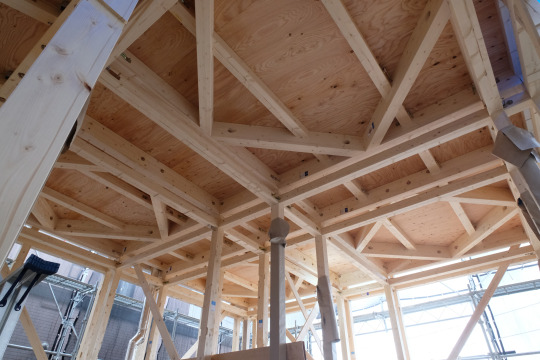
3. Interpretation from ECOLOGICAL point of view
[Bergmann's and Allen's rules]
“Bergmann's rule” is an ecogeographical rule that states that within a broadly distributed taxonomic clade, populations and species of larger size are found in colder environments, while populations and species of smaller size are found in warmer regions. For example, bears living in the southern areas, such as Sun bears, tend to be smaller, while bears living in the northern areas, such as Polar bears, tend to be larger. Conversely, "Allen's rule " refers to the fact that animals that live in colder regions tend to have shorter ears, tails, and other protruding parts than those that live in warmer regions. Polar bears' small ears are said to be following this rule.
When we look at houses in Hokkaido today, we can see that they are generally large, box-shaped, and have flat roofs. The reasons for this can be easily imagined to be that the area of land per house is relatively larger than in urban areas such as Tokyo, and snow ducts are used to deal with snow accumulation instead of letting it fall. And in these points, I suspect we can find " Bergmann's and Allen's rule " as well. Looking again at the houses in Hokkaido today, there are not many eaves, and pitched roofs are not seen very often. The exterior walls also tend to be relatively less uneven. On the other hand, the overall volume of the building seems to be larger than those of narrow houses in Tokyo. These facts suggest that the tendency of the polar bear's body to have a small protrusion and a large volume compared to its surface area seems to be somewhat common to the features of these houses.
The "Bergmann's and Allen's rules" are explained by the issue of heat dissipation. In other words, increasing volume compared to surface area is a device to reduces the amount of heat dissipated compared to the amount of heat produced in the body. The shape of the body of this house is a cube, which is the second smallest geometric form in surface area after a sphere. This house consists of a large cube in the center, with exterior walls with additional insulation surrounding it like "fur," and non-habitable rooms necessary for daily life, such as an entrance and a storage room, attached to it like a "nose" and a "tail”.
The name of this house, "Polar bear," which became somewhat comfortably familiar to us as we began to call it tentatively in the process of designing this house, seems to symbolize the appearance of this kind of northern creature and building.
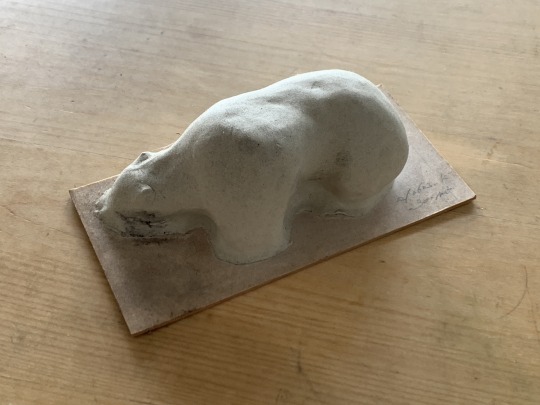
4. Interpretation in terms of FORM
[Suppose you are given a cube with a side of 6.15m.]
The "cube" is very close to an axiom, a form that can never be proven, that has no ground, and that is very close to a logical formula. In other words, it is a very nonsense and meaningless form.
A square box usually has a meaning. Boxes are made in the shape of a square for various purposes, such as to put an apple inside, or for a person to ride on top. However, it is difficult to assign meaning to the square shape itself. The mysterious thing about the form of pure geometry is that even if you try to attach various meanings to why a square is a square, all of these meanings will slip over and over. A square-shaped object (monolith) often looks strange, like something from the future, a leftover from the past, or another world, perhaps because of the groundlessness of its pure geometrical form.
Meanwhile, it is up to us as human beings to make meanings and interpretations of everything and anything in the world. To create meanings for everything and bring the world into existence, that is our agency and our autonomy. Sometimes, architects use terms such as "autonomous architecture" or " heteronomous architecture," but it may just be that this is how it seems from their point of view. It is interesting to consider such autonomy and heteronomy of architecture, but if we focus on the more fundamental subject that we as human beings want to live well, the autonomy of human beings that makes sense of this world, including architecture, seems to be much more important.
For example, suppose you are thinking of building a house. Suppose, for example, that you want to live in a cold climate. Let's put such things that we can somehow make sense of as given conditions and things like cubes, which have no obvious basis and whose meanings we are not sure of, in the same line. In trying to redefine and interpret the meaning of these things, we, the designers and homeowners, become aware of our agency and autonomy, and this may lead to a humane lifestyle in which we actively affirm the environment in which we are placed.
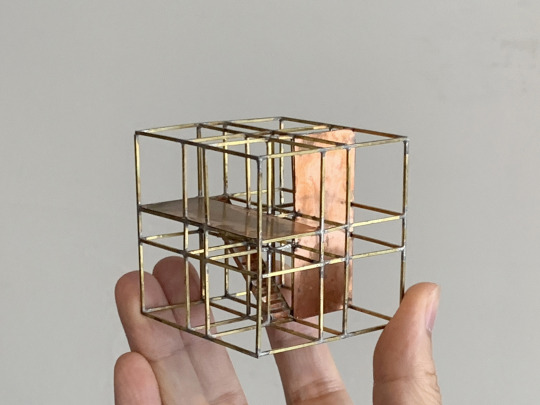
5. Interpretation in the style of Colin Rowe
[The Mathematics of the Ideal Villa]
... and the realization of an idea which is represented by the house as a cube could also be presumed to lend itself very readily to the purposes of Virgilian dreaming. For here is set up the conflict between the absolute and the contingent, the abstract and the natural; and the gap between ideal world and the too human exigencies of realization here receives its most pathetic presentation. …
(Colin Rowe. 1947. The Mathematics of the Ideal Villa. AR)
The basic volume of this house is a 1:1:1 cube, except for the pitched roof volumes added to the front and rear. The configuration of the plane proceeds from front to back in a ratio of approximately 1⁄3 to 1 + √2 to 1 + √2 to 1⁄3, with 1 between the central columns. This ratio configuration is thoroughly maintained for horizontal as well as vertical directions. The fact that the middle span approximates the silver ratio to the center span may be more by chance than Japanese proportional aesthetics, but the extreme compression of the outer span relative to the expanded middle span transfers interest from the center to the middle. Also, the same ratio is thoroughly applied to the three axes, so that eight cubes of 1+√2 appear in the middle part, implying that gravity is equally placed in the center of each cube. In this house, the three-axis symmetrical configuration emphasizes the omnipresence of multiple centers in the middle, rather than their concentration in the center or their dispersion to the periphery.
In this symmetrical configuration with equal symmetry of the three axes, the structural elements such as floors, walls, columns, and beams also participate in the attempt to relativize the top, bottom, left, and right equally. On the right side of the center, the verticality is emphasized by the wall surface that spans the first and second floors of the atrium, while on the left side of the second floor, the horizontality is emphasized by a floor surface the same size as that wall surface. Columns and beams appear horizontally and vertically with the same thickness, and the only suggestion of the existence of vertical forces is the triangular truss members connecting the upper and lower beams. Thus, the verticality of the walls and columns and the horizontality of the floor, which are usually constructed by gravity-based stacking, are here deconstructed, and equal importance is assigned to all six sides of the cube. The six equally gravitated sides, which are not discrete, keep their centers in a geometric placement and make up wholeness.
This ambivalent attitude of avoiding discretization while eliminating centralized hierarchies is probably due to a rhizomatic worldview that recognizes the omnipresence of diverse centers. In a diversified society, what makes a building a house is the life itself, which is expressed as an action, and the "pro-gram" that continuously reproduces, inherits, and brings in customary beauty. Meanwhile, the theory of this house is a kind of postmodernism, a schismatic attempt to bring in the objective aesthetics of the past = mathematical norms, but thereby relativize the construction of the past and deconstruct the dichotomy between concentration and dispersion. And this theory that conflicts with the pro-gram and evokes our universal life force is geometry.
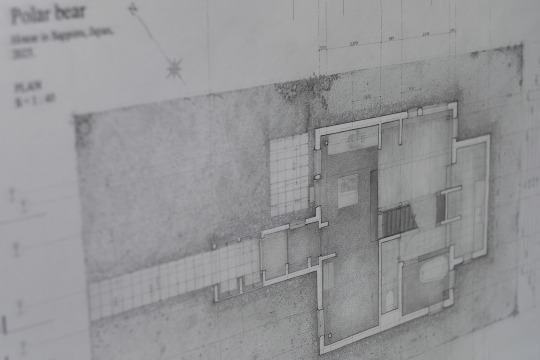
6. Interpretation as MUSIC
[Miles Davis]
“The ambivalence that characterizes Miles Davis' music, persona, and passions, and that accompanies all of his codes of conduct, is a half-and-half mixture of the very straightforward and obvious, and the completely mysterious and unintelligible.” (Translation by the author)
Commentary on Miles Davis by jazz musician Naruyoshi Kikuchi.
“Modal jazz," perfected by Miles, is said to be characterized by improvisation within a scale called a "mode," unlike modern jazz, which was based on chord progressions. And it allowed for more flexible playing through modes, taking chord progressions that had become increasingly complex in the history of jazz up until then, and simplifying them radically.
Mode refers to scales that are different from those of Western music, indigenous and folkloric, such as the Japanese "yona nuki" scale, Okinawan scale, and Indonesian gamelan scale, and Miles is said to have perfected modal jazz when he discovered the African scale of the kalimba. Naruyoshi Kikuchi explains that modes, which are generally composed of seven notes, and modal jazz, which uses these modes, are "very difficult to play if you are asked to play freely with only seven notes because the degree of freedom is too high and the aesthetics and sense of the sound come out obviously.” (Translation by the author)
This house could also possibly be interpreted as modal jazz or even Miles Davis. This house has a "very straightforward and obvious" configuration of 95cm-wide slits horizontally and vertically between eight cubes, but the rationale for this configuration is arbitrary, weak, and "unintelligible" as well. On the other hand, the walls, windows, shelves, and other parts that respond to the daily life are "straightforward" in terms of meaning, but their complex and excessive overall form is "unintelligible.
Therefore, this house could be seen as a "modal jazz" in which a straightforwardly simple configuration is the "code," and the architect's arbitrariness, his/her habits, and the residents' tastes and lifestyles are "improvised" within the "mode" of the region and society of Hokkaido. And this may give rise to a "groove” in which the ambivalence between signification and manifestation vibrates.

0 notes